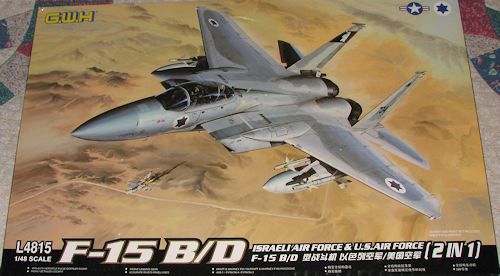
| KIT #: | L4815 |
| PRICE: | $30.00 'used' |
| DECALS: | Four options |
| REVIEWER: | Scott Van Aken |
| NOTES: |

| HISTORY |
The McDonnell Douglas (now Boeing) F-15 Eagle is a twin-engine, all-weather tactical fighter designed by McDonnell Douglas to gain and maintain air superiority in aerial combat. It is considered among the most successful modern fighters, with over 100 aerial combat victories with no losses in dogfights. Following reviews of proposals, the United States Air Force selected McDonnell Douglas' design in 1967 to meet the service's need for a dedicated air superiority fighter. The Eagle first flew in July 1972, and entered service in 1976.
Since the 1970s, the Eagle has been exported to Israel, Japan, Saudi Arabia, and other nations. The F-15 was originally envisioned as a pure air superiority aircraft. Its design included a secondary ground-attack capability that was largely unused. The design proved flexible enough that an all-weather strike derivative, the F-15E Strike Eagle, was later developed, and entered service in 1989. The F-15 Eagle is expected to be in service with the U.S. Air Force past 2025. F-15 versions are still being produced for foreign users, with the F-15 production line set to end in 2019, 47 years after the type's first flight.
| THE KIT |
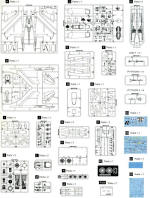 The
last really good 1/48 F-15 kit to be produced was Revell's F-15E Strike Eagle.
Unfortunately for many modelers, that was it so one had to rely on the older,
but still nice kits from Hasegawa and Academy for their big Eagle Fix when it
came to other versions. Both Revell and Monogram have also produced the F-15,
but those are even older molds, though they are perfect for those on a budget.
The
last really good 1/48 F-15 kit to be produced was Revell's F-15E Strike Eagle.
Unfortunately for many modelers, that was it so one had to rely on the older,
but still nice kits from Hasegawa and Academy for their big Eagle Fix when it
came to other versions. Both Revell and Monogram have also produced the F-15,
but those are even older molds, though they are perfect for those on a budget.
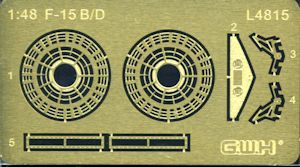
If you are familiar with any of the other GWH 1/48 kits, you know that they provide a great deal of detail. This kit is no exception. Let me start with the easy stuff. First off, there is a small photo etch fret included. This fret contains a small panel for the back of the cockpit, two pieces to go to the rear of the engine, a pair of slime light panels for the rear fuselage and a gun sight for the front seater.
As is the norm with Eagles, the front cockpit and nose section is separate from the rear fuselage. The cockpit section is split vertically and the rear fuselage horizontally. As you'll have to clean up a seam, it is why the slime lights on the rear fuselage are not molded on. The cockpit is well detailed with raised detail on the instrument panels and side consoles. Separate forward panels are provided for the IAF and USAF version. There are decals for each of the instrument. Two different seats are also given; a pair of Escapac IC-7s and a pair of Aces II seats. There are interior sides that will fit onto the sides of the cockpit tub. A separate nose cone is provided so you can show off the radar, though it leaves little room for any weight you may want to add. The avionics panels on either side of the nose are separate and there is black box detail molded into the forward fuselage sections for those who like to have things opened up.
Moving to the rear fuselage, there are two piece full intakes that lead to complete engines. You have a choice of F-100-PW-100 or F-100-PW-220 engines, which differ only in the number of blades of the separate first compressor stage. Each lower wing contains part of the rear fuselage side so that should make things easier to fit. There are separate tail cones as well so you know other variants will be kitted. Intakes can be molded in the upper or lower position. Normally these are lowered when the engine in running. There are separate flaps and slats though they seem to be something one has to glue in the neutral position.
As expected, the speed brake is separate and can be posed raised, though it rarely is when on the ground except to show off to crowds at shows. The canopy can also be posed raised or lowered. At the rear are single piece stabilizers and tail fins with separate rudders. The small counterbalances/RWR antennas atop the fin are separate pieces as well. Landing gear and wheels are nicely done. The gear doors can be installed up or down and most of you who have seen F-15s on the ground realize that many of these doors are normally up unless maintenance is being done in the wells.
The kit comes with a great selection of dangly things that includes a centerline and fuselage drop tanks. The weapons load includes Python 2 and 4 missiles as well as AIM-7s. As with their MiG-29 kits, these missiles are individually packaged in a nice blister pack to prevent damage. If you want Sidewinders you'll have to hit the spares bin or Hasegawa Weapons Set. I am not sure if the USAF two seater was able to use the AIM-9s, but I'd be quite surprised if not. Obviously GWH wants you to build the IAF version.
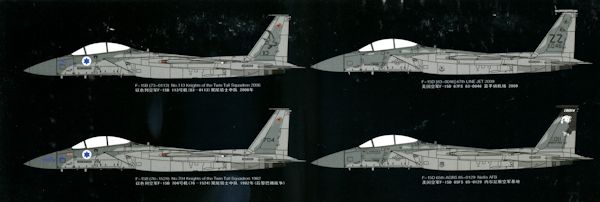
Instructions are just superb. It is GWH's usual book style and
includes clearly drawn illustrations that provide all the markings and painting
information. There are four full pages for stencil markings and one for
missile/pylon/tank markings. With all these pages, you'd think there would be a
lot of decals. There are. The kit includes four sheets. The largest and one of
the middle size sheets are only for stencils. The smallest one is for weapons
and such. The other middle size sheet has unit markings and this is the only one
I've shown. All four planes are in the older scheme of light and dark ghost
grey. This may not be appropriate for the US planes which were probably in the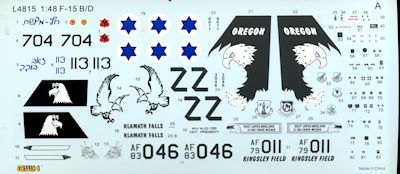 later Mod Eagle scheme. The two IAF planes are listed as being from 704 and 113
'Knights of the Twin Tails' squadrons. The USAF versions are listed as from the
67 FS in 2009 (so it will be in Mod Eagle camo), and the 64 AGRS at Nellis.
This second one is clearly from the 114 FS at Kingley Field, Oregon ANG and it
will also be in Mod Eagle camo. The decal sheets are all nicely printed and if
you insist, you can find a lot of aftermarket options for both the B and D two
seaters.
later Mod Eagle scheme. The two IAF planes are listed as being from 704 and 113
'Knights of the Twin Tails' squadrons. The USAF versions are listed as from the
67 FS in 2009 (so it will be in Mod Eagle camo), and the 64 AGRS at Nellis.
This second one is clearly from the 114 FS at Kingley Field, Oregon ANG and it
will also be in Mod Eagle camo. The decal sheets are all nicely printed and if
you insist, you can find a lot of aftermarket options for both the B and D two
seaters.
| CONCLUSIONS |
I dare say that you can consign all your two seat standard Eagles to the 'has-been' shelf of your collection. This one seems to have everything that has gone before it eclipsed and will certainly make into a superb model when finished.
| REFERENCES |
http://en.wikipedia.org/wiki/F-15_Eagle
January 2023
Thanks to the annual IPMS Gateway Auction for providing this one at such a decent price.
Copyright ModelingMadness.com. All rights reserved. No reproduction in part or in whole without express permission.
If you would like your product reviewed fairly and fairly quickly, please contact the editor or see other details in the Note to Contributors.